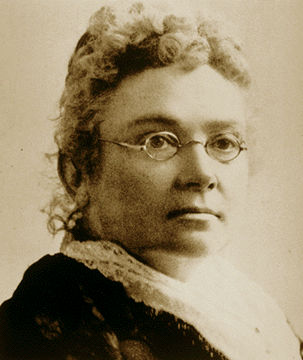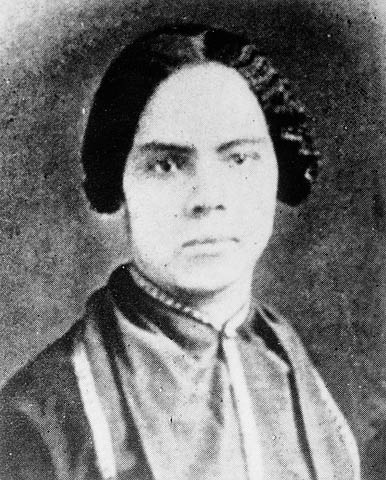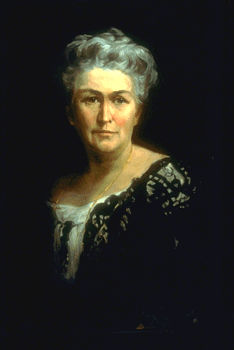Ontario became the fifth province to grant women the right to vote on 12 April 1917, after more than half a century of activism by suffragists. Beginning in the 1870s, Ontario’s suffrage movement emerged from the vibrant nation-wide mobilization of middle class women who sought political representation as a means to improve women’s rights and assert influence in social, economic and political reform.

Ontario became the fifth province to grant women the right to vote on 12 April 1917, after more than half a century of activism by suffragists. Beginning in the 1870s, Ontario’s suffrage movement emerged from the vibrant nation-wide mobilization of middle class women who sought political representation as a means to improve women’s rights and assert influence in social, economic and political reform. The first Ontario suffragists were a cohort of predominantly White, Anglo-Protestant, educated women led by Dr. Emily Stowe (1831–1903) and later her daughter, Dr. Augusta Stowe-Gullen (1857–1943). Suffrage was also of interest to Black women abolitionists, supporters of temperance, and socialists. Although there was a range of political ideology among suffragists, the two most dominant views either emphasized women’s equality with men or idealized women’s maternal nature as justification for the vote. Ontario suffragists largely pursued change by working within the established legal and political system, and did not exhibit the militancy found in parts of the American and British movements.
Collaborating with their counterparts in Western Canada, the United States and Britain, Ontario's suffragists raised awareness and support for their cause through the formation of organizations, participation in national and international meetings, petitions and lobbying at the municipal and provincial levels, political theatre and political writing. Much of the suffrage activism occurred in urban and rural Southern Ontario, with Toronto being the headquarters of provincial suffrage organizations. Suffragists’ efforts were ridiculed by male and female opponents who countered that women neither needed, nor wanted the vote.
Amid suffrage victories in Western Canada in 1916, the Ontario legislature succumbed to pressure and finally voted in favour of women’s suffrage. Not all female residents in Ontario received the provincial franchise in 1917. As with men, voting eligibility was restricted to women over 21 years of age, who were born or naturalized British subjects and who had lived in the country for 12 months. Other women originally excluded from the vote were Indigenous women living on reserves, female prison inmates, and residents of asylums and charitable institutions.
Early Rights
Several traditional Indigenous societies living on or near Lake Ontario had strong matrilineal structures in which women held positions of power. Among the Haudenosaunee, clan mothers—female elders who carried the hereditary rights to represent different nations of the confederacy—were tasked with using their knowledge of the Great Law to responsibly appoint, observe or remove the authority of (male) chiefs and faith keepers. Under centuries of colonization, however, the influence of patriarchal European settlers eroded many of Indigenous women’s traditional rights.
The non-Indigenous women residing in Upper Canada, including British settlers, White American Loyalists, Free Blacks and slaves of African origins, lived in a highly patriarchal society which offered women limited political rights, legal protection or opportunities for economic independence. Most significantly, under British common law a married woman had no right to own or sell property, or have control over how her own wages were spent. Until the mid- to late-19th century, most women were barred from higher education and professional careers.
Initially the governance structure of Upper Canada did not explicitly prohibit women from voting; the Constitutional Act of 1791 defined voters as “persons” who owned property of a certain value, with no mention of eligibility by sex. Technically this should have allowed unmarried women and widows with property to vote, yet the absence of women’s voting records in Upper Canada suggests that women with property qualifications were not expected or allowed to claim voting privileges.
Like its predecessor, the 1840 Act of Union did not include any restrictions of voter eligibility based on sex. Nevertheless, the first piece of evidence that propertied women voted in Canada West (formerly Upper Canada) appears in 1844—a complaint raised by a defeated Reform candidate who protested that seven women voted for his Tory opponent.
When the Reform party came to power in 1849 they added the first clause in Canada’s electoral laws that specifically excluded women from voting. One exception was made in 1850, to allow women who met property qualifications, be they married or single, to vote for and be elected as school trustees, though few women availed themselves of this opportunity until the 20th century.
Between 1859 and 1873, petitions and letters to editors written by women cited cases of abuse and abandonment of wives as reasons to improve women’s property rights. These campaigns resulted in moderate amendments allowing married women the right to own, but not dispose of, any property inherited before marriage.
In 1867, with Confederation, the British North America Act (now the Constitution Act, 1867) made voter eligibility a provincial matter. Women’s exclusion from voting in municipal, provincial and federal elections continued in the newly formed province of Ontario until the formation of a women’s suffrage movement in the late 1870s challenged the status quo.
Toronto Women’s Literary Club
The founding of the Toronto Women’s Literary Club (TWLC) in 1876, an organization dedicated to women’s education, was the launching pad of the suffrage movement in Canada. Founded by Dr. Emily Stowe, the first woman physician to practise medicine in Canada, the TWLC provided a weekly meeting space and community for educated women—a radical concept, considering clubs were traditionally the domain of men. Stowe was inspired to start the TWLC after attending the American Association for the Advancement of Women, a conference bringing together different women’s study groups. TWLC members pursued intellectual growth through the study of literature, science, music, theatrical performance and guest lectures, which often prompted discussions on the status of women, among other social and civic reform issues. In 1881, Canada Citizen, a Toronto weekly paper, showed its support to the club by devoting a column to women’s reform issues written by TWLC member, Sarah Anne Curzon.
Also in 1881, the TWLC sent the first delegation to the provincial legislature asking for women’s suffrage. The club’s efforts resulted in a new law that allowed all women with property qualifications the right to vote on bylaws and minor municipal matters. Inspired by this success at the municipal level, the TWLC disbanded in 1883 and reconstituted as the Canadian Women’s Suffrage Association (CWSA) to openly foster its members’ pursuit of women’s suffrage. Unlike the TWLC, the CWSA also included men as members. In 1884 a further amendment granted unmarried women and widows the right to vote in municipal elections.
While the development of the CWSA was a significant landmark in suffrage history, two earlier examples of women’s collective action are equally important: Black women abolitionists and the Woman’s Christian Temperance Union. Both demonstrate early mobilization for social change and electoral reform.
Black Women Activists
Black women in Southwestern Ontario were among the first women activists in Canada to organize and advocate for civil rights. Mary Bibb and Amelia Freeman Shadd organized literary and social clubs for women in Windsor and Chatham in the 1850s, predating the TWLC by two decades. In 1853, prominent abolitionist Mary Ann Shadd was the first female publisher and editor of a North American newspaper, The Provincial Freeman, which reported on Black men’s voting rights and the origins of the women’s suffragemovement in the United States.Although Black women would remain on the periphery of the mainstream suffrage movement in Canada, Shadd would return to the United States to found the Colored Women’s Progressive Franchise Association in 1880.

Woman’s Christian Temperance Union
Founded in Owen Sound in 1874 by Sunday school teacher Letitia Youmans, the Canadian branch of the Woman’s Christian Temperance Union (WCTU) grew out of late-19th century evangelical social reform (see Social Gospel). Spreading quickly across the province and country, the WCTU framed temperance as a middle class women’s issue, arguing that prohibition and personal sobriety would alleviate domestic violence, sex work and poverty, thus improving the standard of living for working class and poor women. Despite common interests, the WCTU was initially reluctant to support suffrage, as they believed that women’s influence was more beneficial at home than at the polling station. Ontario branches of the WCTU broke ranks to become a strong ally of the CWSA in 1891, rationalizing that women voters were critical to getting temperance legislation passed. The Dominion WCTU followed with support of suffrage five years later.
Activism in the Late-19th Century
The mobilization of new women’s organizations in the late 19th century, often with overlapping membership, helped raise awareness in the press and legislature about the ways Ontario’s laws failed to protect women. Throughout the 1880s and 1890s, the CWSA and its allied organizations focused on gaining the municipal vote for married women and the provincial franchise for all women. More than one hundred petitions to town councils and the provincial government were made between 1884 and 1888. Liberal Member of Provincial Parliament (MPP) John Waters (Middlesex North) diligently supported the cause, introducing nine bills in favour of women’s suffrage between 1885 and 1893. Interrelated crusades were opening more universities to women and improving married women’s property rights. Finally, in 1884, Ontario granted married women the right to own property and manage it without consulting their husbands.
Dominion Women’s Enfranchisement Association
Inspired by a visit from American suffragist Dr. Anna Howard Shaw, Stowe created a new suffrage association in 1889, the Dominion Women’s Enfranchisement Association (DWEA), where she served as president until her death in 1903. The DWEA hoped to establish itself as a national network and federated with the newly formed National Council of Women of Canada (NCWC) in 1893, though much of its activity remained in Ontario. It continued to make links internationally and nationally with visits from American suffragist Susan B. Antony in 1889 and a national convention in 1890. Although no progress was made at the provincial or municipal levels, in 1892 three women—including Dr. Stowe’s daughter, Dr. Augusta Stowe-Gullen—were elected to the Toronto School Board for the first time. In 1894, 150 delegates from the DWEA and WCTU made a joint visit to Premier Oliver Mowat. Although the premier expressed sympathy for their cause, this visit was followed by a period in which no new bills were introduced on women’s suffrage between 1893 and 1905.
Opponents to Women’s Suffrage
Most Liberal and Conservative politicians attempted to placate suffragists by explaining they were not opposed to women’s suffrage in principle. They did, however, argue that they could not amend the franchise when it appeared to be only of interest to a minority, and thus not representative of most women’s wishes. Those more antagonistic to the movement equated women’s suffrage with the complete upheaval of social and family values or viewed suffrage in opposition to God’s divine plan for men and women. Meanwhile, female opponents of women’s suffrage, such as home economics matron and founder of the Women’s Institute, Adelaide Hoodless, objected to enfranchisement on the grounds that women already could effect change by asserting their influence within the family and community, thus avoiding the corruption of politics. Even the NCWC did not support suffrage until 1910 because they deemed it too controversial. The variety of opposition rhetoric was satirized by the DWEA in their 1896 mock parliament, an act of political theatre that featured women pretending to be members of parliament voicing objections to a delegation of men demanding the vote.

Ontario Socialist League
A new century brought renewed energy and new participants into Ontario’s suffrage movement. Socialist groups emerged in Canada at the turn of the 20th century and offered support to the “Woman Question,” arguing that a socialist revolution would emancipate women from patriarchy. Much like the WCTU, they recognized that female voters could help their cause; thus, the Ontario Socialist League (OSL) put universal suffrage on their platform in 1902. The OSL supported the efforts of their member, Margaret Haile, to run for a seat in the Ontario provincial election as the first female candidate, an act endorsed by Stowe-Gullen. Haile, a teacher and journalist, lost the election, receiving just over 70 votes. At a time when most socialist women worked within their organizations behind the scenes, Haile was an exceptional public figure.
Canadian Suffrage Association
The DWEA became the Canadian Suffrage Association (CSA) in 1906. Continuing her mother’s legacy, Stowe-Gullen was its first president. Despite its national name, the CSA operated predominantly in Ontario, focusing on achieving provincial suffrage. The suffrage association worked with new proponents of women’s suffrage, including Toronto Mayor Emerson Coatsworth, Liberal MPP John Smith (Peel) and Labour MPP Allan Studholme (Hamilton East), all of whom introduced resolutions and bills, despite a frosty reception from Conservative Premier James P. Whitney. Of particular note was the 1909 petition by the CSA. Working in conjunction with 13 other reform groups and women’s organizations, the CSA presented Whitney with 100,000 signatures supporting suffrage. The considerable efforts received praise in the Toronto Globe, but Whitney offered no commitment. The same year, Toronto hosted the International Council of Women meeting, which drew together women activists from Europe and North America. Later in the year, British suffragettes Emmeline Pankhurst and Ethel Snowden visited Toronto, offering support and inspiration to their Canadian counterparts.
In 1911, Flora MacDonald Merrill Denison, a dressmaker and writer, became CSA president. While Denison represented Canada at two meetings of the International Woman Suffrage Alliance in Europe, her socialist leanings, support for birth control and divorce, and her defence of the militancy of British suffragettes were ultimately deemed too contentious for her to remain CSA president. Denison resigned in 1914 and was replaced by Dr. Margaret Gordon. As former vice president of the CSA and president of the Toronto Suffrage Association, Gordon’s previous efforts had been focused on the municipal vote. In 1914, Gordon contacted approximately 850 Ontario town and city councils about enfranchising women. In response, 161 communities sent petitions in favour of extending the municipal franchise to women and 33 held favourable referenda on the subject. Although the majority of the legislature remained antagonistic towards suffrage, more and more Ontarians appeared open to extending women more political rights.
Winning the Vote
The urgency of the First World War (1914–18) both stunted and invigorated the provincial suffrage crusade. Many suffragists shifted their volunteer efforts to patriotic war work, while a minority turned to peace work. Others used women’s wartime volunteerism and paid labour as proof women deserved equal citizenship rights. With new Premier William Hearst in office, the CSA and their handful of allied Liberal MPPs rallied support for a succession of delegations and bills in 1915–16. While these efforts were defeated, suffrage victories in Manitoba, Saskatchewan and Alberta in 1916, followed by British Columbia in early 1917, forced change in Ontario. The Liberal Party of Ontario officially endorsed women’s suffrage just before the legislature opened in 1917. With Conservatives at the federal level seeing women’s suffrage as favourable to their conscription cause, Ontario Conservatives were quick to join the Liberals in a unanimous vote supporting a bill in favour of women’s suffrage in February 1917. On 12 April 1917, both The Ontario Franchise Act and The Election Law Amendment Act received royal assent. Fifty-one years after the TWLC was founded, Ontario women finally had the vote.
Women in Political Office
Ontario was the first province to elect a woman to the House of Commons. Teacher Agnes Macphail (Southeast Grey County) was elected in 1921 as a Member of Parliament (MP) first for the United Farmers of Ontario, and later for the Progressive Party and the Co-operative Commonwealth Federation. As a federal MP between 1921 and 1940, Macphail advocated for the rights of farmers and rural issues, as well as the rights of workers, seniors, children and women. Canada’s first female senator also hailed from Ontario: Carine Wilson, a Liberal from Ottawa with extensive volunteer experience in women’s and refugee issues, was appointed to the Senate in 1930.

It was not until 1919 that a bill was passed giving Ontario women the right to hold political office at the provincial and municipal levels. Some notable firsts at the municipal level include Constance Hamilton, elected to Toronto City Council in 1920, and Barbara Hanley, elected mayor of Webbwood in 1936. It was not until 1943, when Macphail was elected to the provincial legislative assembly, joined by fellow CCF MPP Margaret Rae Lucock (Bracondale), that women held office provincially. In 1972 Margaret Birch, a Progressive Conservative MPP from Scarborough East, was the first woman appointed to an Ontario cabinet position.

In 1954, Status Indians in Ontario were granted the right to vote in provincial elections; this included women. Federally, Indigenous women living on reserves did not gain suffrage until federal amendments were made in 1960, but Indigenous women could hold office on reserve beginning in 1951. In 1954, Elsie Knott became the first female chief in Canada, leading the Anishinaabe Curve Lake First Nation, northeast of Peterborough.
Legacy
The women’s suffrage movement in Ontario was critical to raising awareness and legislative changes that would improve women’s political, legal and economic rights. Furthermore, suffrage activism resulted in a more comprehensive vision of democracy in Ontario. After achieving the vote, Ontario women continued to be active in political causes, exercising their right to vote, standing for office and forming organizations dedicated to social change and equality.

 Share on Facebook
Share on Facebook Share on X
Share on X Share by Email
Share by Email Share on Google Classroom
Share on Google Classroom